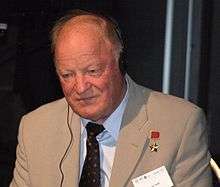Igor Volk
Igor Petrovich Volk (Russian: Игорь Петрович Волк, Ukrainian: Ігор Петрович Волк; 12 April 1937 – 3 January 2017) was a Soviet cosmonaut and test pilot.
Igor Petrovich Volk | |
|---|---|
Игорь Петрович Волк | |
 Volk in 2008 | |
| Born | 12 April 1937 |
| Died | 3 January 2017 (aged 79) |
| Education | Kirovograd Military Aviation School of Pilots (1956) Fedotov Test Pilot School (1965) Moscow Aviation Institute (1969) |
| Occupation | test pilot, cosmonaut |
| Years active | 1956 – 2016 |
| Employer | Gromov Flight Research Institute (1965-2002) |
Notable work | MiG-21I testbed maiden flight |
| Awards | Hero of the Soviet Union Honoured Test Pilot of the USSR |
| Space career | |
| Cosmonaut | |
Time in space | 11d 19h 14min |
| Selection | Air Force Group 5 |
| Missions | Soyuz T-12 |
| Signature | |
 | |
Military and test pilot
Volk became a pilot in the Soviet Air Force in 1956. After graduation from the Fedotov Test Pilot School in 1965, he has joined the Gromov Flight Research Institute.[1][2] He logged over 7000 flight hours in over 80 different aircraft types. Over the years, he flew on all types of Soviet fighters, bombers, and transport aircraft. He showed outstanding abilities in complex tests of various airplanes at critical angles of attack, stall, and spin. He was the first who tested aircraft behavior at high super-critical angles of attack (around 90°) and performed aerobatics such as the "cobra" maneuver.[3]
Space program

Igor Volk was selected as a cosmonaut on 12 July 1977 and flew as Research Cosmonaut on Soyuz T-12, the 7th expedition to Salyut 7. One goal of the mission was to evaluate the effects of long-duration spaceflight on a pilot skills and ability to fly and land an aeroplane safely (in order to prove Volk's ability to control Space Shuttle Buran atmospheric segment of flight).[3] He served as the head of pilot-cosmonaut training department for the Buran program and later (after the project's cancellation) worked for the Gromov Flight Research Institute as a Flight Tests Deputy Chief before retiring in 1996. He previously served as President of the National Aero Club of Russia and Vice President of the Fédération Aéronautique Internationale. As recognition for his contributions as a test pilot and cosmonaut he was awarded the Hero of the Soviet Union on 29 July 1984.
Other accomplishments
Volk was also an inventor and was planning a new four-person concept flying car, called the Lark-4 which takes off and lands at 45 km/h (28 mph) using a 27-meter (89 ft) runway. It consumes 11 litres (3 gallons) of fuel for every 100 km (62 mi) traveled and cruises at around 637 km/h (396 mph).
Personal life
Volk was married and had two children.
He died on 3 January 2017 while on holiday in Plovdiv, Bulgaria. He is buried together with his daughter at the Bykovskoye Memorial Cemetery in Zhukovsky.[4]
Honours and awards
Memory

Bust of Igor Volk is installed at Solnechnaya Street in the city of Zhukovsky.[5]
References
- Знаменская, Наталья, ed. (2002). ШЛИ со временем [ShLI in Time] (in Russian) (2 ed.). Жуковский: ООО "Редакция газеты "Жуковские вести". p. 400.
- Evans, Ben (2012). Tragedy and Triumph in Orbit: The Eighties and Early Nineties. Springer Science & Business Media. p. 614. doi:10.1007/978-1-4614-3430-6. ISBN 9781461434306.
- Hall, Rex; Shayler, Davide; Vis, Bert (2005). Russia's Cosmonauts: Inside the Yuri Gagarin Training Center. Chichester, UK: Praxis Publishing. pp. 335–6. ISBN 0-387-21894-7.
- "Cosmonaut Igor Volk dead at 79". SpaceFlight Insider. 4 January 2017. Retrieved 11 January 2017.
- "Установка бюста Героя СССР Игоря Петровича Волка" [Installation of a bust of the Hero of the USSR Igor Petrovich Volk]. ЛИИ им. М.М. Громова (in Russian). 13 April 2020. Retrieved 15 April 2020.
External links

- Detailed biography of Igor Volk
- Biography at Astronautix